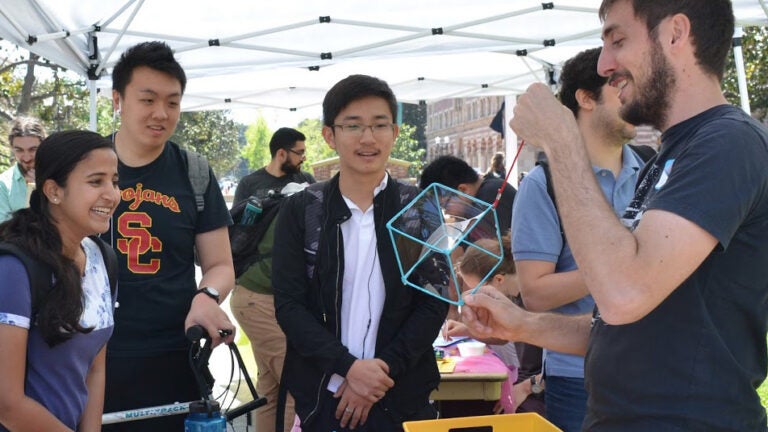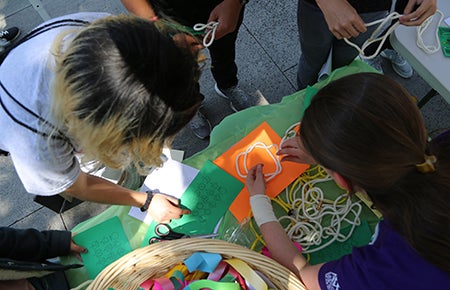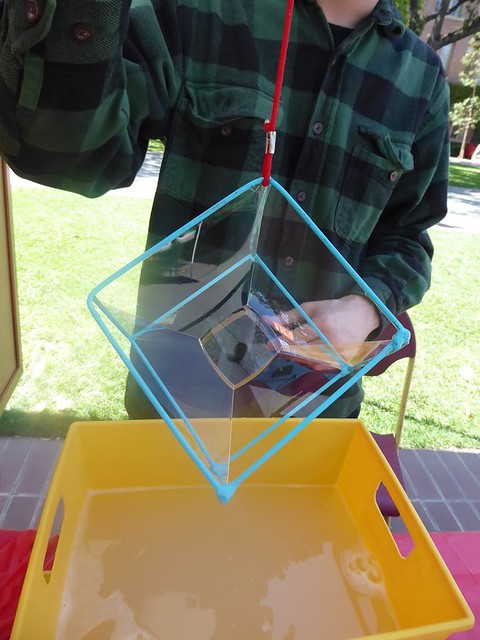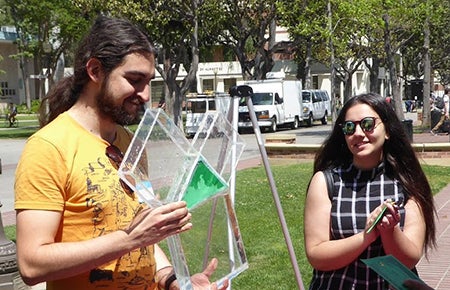
The third annual Mathematics Festival brings math to the people
“There’s this thing called ‘math anxiety,’” Can Ozan Oguz is telling me. I nod seriously. I know the affliction well.
“Many people admit they don’t understand math, or say they are not good at it,” he continues. “Part of this has to do with having required math forced on them, as opposed to being very interested in a problem and attempting to solve it.”
We are standing on Trousdale Parkway on the University Park campus, next to a group of booths set up as part of the 2017 Mathematics Festival. Though windy, the sky is predictably sunny, and clusters of students are milling around, checking out the action. Co-organizers and mathematics Ph.D. students Oguz and Ezgi Kantarcı teamed up with a host of Mathematics Graduate Student Association (MGSA) members to put the third-annual event together.
Six stations are manned by graduate students or a faculty lecturer and each is devoted to a different branch of math: combinatorics, number theory, topology, statistics, geometry, or analysis and probability. The tables feature games, activities or demonstrations that illustrate mathematical concepts. In addition to custom-made ice cream sundaes, a raffle draws in participants. Nothing wrong with a little incentive.
“By visiting tables, doing activities or just interacting with the people at the booths, participants get to learn something about mathematics,” Oguz explains. The festival was designed to showcase math that is not necessarily part of the undergraduate curriculum, introducing non-math majors to material that is as beautiful as it is interesting.
For Oguz, math is essentially about understanding, creativity, aesthetics and searching for absolute truth. “Our goal is to show that math is more than the classes you are required to take — and it is usually not the homework you are required to do.” Indeed, this explains a lot. To me at least.

Graduate student Ilknur Egilmez leads a demonstration of knot theory at the topology table. Photo by Mike Glier.
Let the games begin
I wander over to one of the tables. The atmosphere is surprisingly festive, and I start chatting with two girls who turn out to be high school students from Lennox Mathematics, Science & Technology Academy in nearby Lennox, Calif. MGSA invited students from two high schools to join the USC attendees this year.
Citlalli Vazquez, a junior from Lennox, tells me about the topology table where they just saw some demonstrations to illustrate different kinds of geometry. She and her friend had just learned about Möbius bands, she said, a special shape made out of paper that only has one surface and one bounding side, as opposed to a regular sheet of paper, which has two sides.
“My mind was blown,” Vazquez says, her eyes wide and eyebrows high.
“Aw, that’s cute,” I think. Little do I know my mind is about to be blown, as well.
I make a beeline to the topology station where I meet graduate student Ilknur Egilmez. She smiles as she hands me a wide strip of paper whose ends are stapled together to form a loop — a short cylindrical shape with a clear top and bottom boundary. She asks me to cut it in half lengthwise, which creates two narrower loops.
Next, she hands me a Möbius band, a colorful, pearlescent strip of paper that has been twisted once and then joined at the ends.
“So if a little ladybug crawled all along the surface of this strip, it would cover the whole length — and both sides of the paper — and come right back to its starting point without crossing a boundary,” Egilmez explains, demonstrating with her fingertip.
Then she asks me to cut that twisted loop in half, in the same way as the paper cylinder. To my amazement — nay, delight! — the Möbius loop does not become two separate loops. Rather, it unfurls into one long, narrow piece even more twisted than the previous version. The high school kid was right!

Getting in shape
At a neighboring table, a jocular graduate student named Giuseppe “Peppe” Martone is illustrating the Pythagorean Theorem with 3-D visuals. We can probably all remember that gem of Greek knowledge: For a right triangle, the square of the length of the hypotenuse is equal to the sum of the squares of the perpendicular sides, or a2 + b2 = c2.
Martone holds up an odd-looking clear plastic apparatus, the handiwork of freshman Yiqiu Shen. Partially filled with water, its bottom half is a narrow, square-shaped container while the top half is made up of two smaller squares and a right-triangle. When the contraption is held upright, the water fills the bottom half exactly.

Can Ozan Oguz holds an apparatus designed to prove the Pythagorean Theorem visually using water displacement. Photo by Fanhui Xu.
“When I turn this box upside down, do you think the water will completely fill the shapes on the other end?” Martone coyly asks the crowd.
Spoiler alert: It does! And thus proves the Pythagorean Theorem, in three-dimensional glory.
Martone moves on to a minimal surface demonstration using soap bubbles and 3-D shapes made with thin plastic frames. He first submerges a triangular pyramid, or tetrahedron, into a bucket of soapy water. As he gingerly lifts it out, I can see that a bubble is filling the interior — but it takes a completely unexpected shape. All planes of the soap bubble meet in the middle, which, I soon learn, creates the most efficient shape with the smallest possible surface area. The result using a cube shape is even more mind-boggling.
This demonstration is a real crowd-pleaser. Right now, Martone is the man.
Math = Creativity
After I stop at a few more stations, I see Oguz again, and he approaches me with an expectant smile. “Are you enjoying the festival?”
I honestly am. I tell him how impressed I am by the demonstrations, how genuinely amazing they were, and that they all reinforced for me the tremendous creativity that is inherent to mathematics.
“Most people relate creativity with art or advertising, but people have been creating math for such a long time,” Oguz muses. “Well, most people think that math is created by humans. But this poses a bigger question: Is math created by God and we only discover it because we work on it? Or are we the ones actually creating it?”
I wonder if there’s a Philosophy Festival coming up soon.
The 2017 Mathematics Festival was made possible with the help of many other volunteers, including Maxwell Siegel, Melike Sirlanci, Guher Camlıyurt and Assistant Professor (Teaching) of Mathematics Neelesh Tiruviluamala.